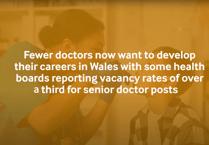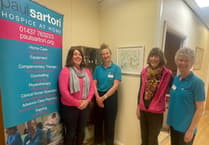Hywel Dda University Health Board covers a quarter of the land mass of Wales with poor public transport, one of the oldest populations in Wales, and a population that grows significantly during the peak holiday periods.
We have a strategy, agreed after extensive consultation with the public and clinicians in 2018 A Healthier Mid and West Wales, to fundamentally improve the whole system of healthcare in West Wales, based on the Welsh Government’s A Healthier Wales and the Well-being of Future Generations (Wales) Act 2015.
We plan to do this by:
- Bringing as many services as possible into the community and closer to people’s homes;
- Introducing a connected set of integrated health and well-being centres in our key town centres in West Wales;
- Creating more community hospitals closer to people’s homes for rehabilitation, end of life care, diagnostics, outpatients, maternity, chemotherapy, mental health advice and support, minor injuries and more; and
- Improving the specialist care we can provide people by building a new urgent and planned care hospital and bringing back some specialist services from Swansea and beyond.
Currently, we have four acute hospitals in some of the oldest healthcare buildings in Wales, parts of which are no longer fit purpose, and we have five community hospitals.
A consequence of so many acute hospitals is rotas that are much less attractive to clinicians compared to those offered by other Health Boards in Wales, and a lack of critical mass to provide the experience that clinicians seek to develop their careers. This makes it very difficult for us recruit. At any one time, we have between 780 and 900 vacancies for nurses and doctors. We therefore have to use expensive agency staff, which risks poorer quality of care, fragile services collapsing, and leads to the endemic financial problems, which go back decades. The condition of our estate can mean a relatively poorer patient and staff experience and challenges in the prevention and control of infections.
In Pembrokeshire, our strategy proposes integrated health and well-being centres in Haverfordwest, Fishguard, Narberth, Milford Haven, Tenby and Pembroke Dock.
In Carmarthenshire, proposals are for Carmarthen, Amman Valley, Llandovery, Cross Hands, and Pentre Awel, Llanelli; and
In Ceredigion, in Aberystwyth, Tregarron, Lampeter, and Llandysul, with sites already operational in Aberaeron and Cardigan.
These will provide a range of services, such as outpatients, diagnostics, GPs, district nurses, therapies, audiology, social care, third sector and more, as already successfully established in Aberaeron and Cardigan integrated care centres.
We intend the integrated health and well-being centres to be built before the specialist new urgent and planned care hospital, so the vast majority of people’s health care in Hywel Dda will be provided closer to their homes. This is so important in our vast rural area of West Wales.
Subject to approval by Welsh Government of our Programme Business Case, which was submitted in January 2022, it is intended the new urgent and planned care hospital will be built around 2029.
A site for the proposed new urgent and planned care hospital is undergoing detailed consideration by four appraisal groups, reviewing the technical, clinical, workforce, economic and financial issues of the five shortlisted sites (one in Narberth, two in St Clears and two in Whitland). Their recommendations will be considered by the Health Board on 4th August 2022.
The new hospital will ensure all surgical and medical specialties are strengthened by bringing together Withybush and Glangwili hospital rotas. This will:
- Reduce reliance on locum and agency staff which affects quality and safety of care and experience of our patients;
- Build more realistic and attractive set of rotas for clinicians working in our urgent and emergency care services;
- Bring together staff to create a critical mass, which will result in being able to retain and develop specialisms. People currently have to travel past Withybush Hospital to our acute hospitals in Carmarthen and Llanelli for obstetrics, neonates, acute urology, GI bleeds, complex respiratory, coronary angiography, complex joint surgery and higher risk gynaecology, and more of these and other services will all be provided closer to Pembrokeshire in the new hospital;
- Enable us to explore with Swansea Bay UHB, provide some tertiary services, such as Radiotherapy, Neurology and Cardiac Catheterisation in West Wales;
- Create the critical mass needed for clinicians to focus on education and training, to improve the quality of the training experience and the numbers of trainees who are more likely to remain in West Wales; and
- Create more opportunities for clinicians to engage in research and innovation, improving access to our population to research studies, and recruitment, as the highest quality clinicians demand access to research and innovation activities
Learning from the pandemic, the new hospital will separate planned and emergency care and reduce the risk of emergency activity negatively impacting on planned care, through cancelled operations.
The Health Board does not intend to make changes at Glangwili or Withybush hospitals until the new hospital is built (we think the new Urgent and Planned Care Hospital will take until at least the end of 2029 to open). And there will be regular engagement - listening and working with our communities, and our partner organisations, and possibly consultation on parts of the programme.
Following the development of the new hospital, Withybush and Glangwili hospitals will operate as local community hospitals, with therapy and nurse-led beds, providing:
- Same day emergency care for ambulatory (walk-in) conditions, with GP-led urgent care centres/minor injury units ( based on the success of the Prince Phillip Hospital model in Llanelli);
- Step-up and step-down beds that will provide an alternative to a hospital stay for people who need more care than can be provided at home, and enable people to be discharged from hospital if they need a period of rehabilitation; and
- Facilities for some day case procedures and tests, like x-ray, ultrasound, and mammography.
We have acknowledged that for some of our communities (particularly some parts of coastal Pembrokeshire and northern parts of Carmarthenshire and Southern Ceredigion) travel times to the acute hospital will be longer. The zone is based on the area within an hour’s reach of the majority of the Hywel Dda population, where they are not able to access another hospital.
Detailed analysis undertaken by the Welsh Ambulance Services NHS Trust (WAST) identified that by placing a new hospital in the identified location: 98% of 999 calls would be able to reach the hospital within an hour, 93% of the population would be within one hour of an A&E, by car; and 91% of the population would be within one hour of a planned inpatient care hospital by car.
With a bigger and more sustainable hospital configuration, we are much more likely to avoid the very long waits our population experience to get an ambulance, be admitted to A&E and to see a doctor. The corollary to this is carrying on with our current fragile services runs a high and increasing risk that we will be faced with an unplanned service reduction at some point in the future, which would result in patients having to travel to Carmarthen or even further.
We are committed to work with our communities most effected by the change, to expand first responder and other schemes to ensure that appropriate responses are even faster than they currently are with ambulances.
In the event of a major emergency at Valero, the approach now would be to take our clinicians to the site in the first instance to triage and send patients to the relevant hospital (e.g. Swansea Bay UHB for burns). This would be supported by WAST and the Emergency Medical Retrieval and Transfer Service (EMRTS) as a major incident. Withybush Hospital would have a limited role and only take patients they could treat (walking wounded, minor trauma etc). Glangwili Hospital is our Interim Trauma Unit until the new urgent and planned care hospital is built. Bronglais and Withybush hospitals will act as Rural Trauma Facilities, a newly recognised and unique hospital designation for South Wales, recognising the geographical isolation of parts of our Health Board area and the need to maintain a trauma response.
The development of the new hospital would not have a detrimental impact in a scenario such as this. Indeed, with a bigger hospital with the greater critical mass of staff and specialists, it is likely that more classes of patients could be treated in the Hywel Dda area than is currently the case.
With regards to the “golden hour”, paramedics are highly trained and can often provide the immediate care required to allow the extra journey time for patients to be treated at the most appropriate hospital. WAST is finalising a review of ambulance capacity and has acknowledged the need for a greater degree of paramedic support in West Wales. This, together with the new hospital, will help avoid ambulance waits and give greater access to paramedic support across our communities. Some emergencies would also see the response of clinicians, including consultants, at the scene from the EMRTS.
We have a Major Trauma Network across South Wales, West Wales and Powys to transfer patients rapidly to the Major Trauma Centre in Cardiff. We continue to see advances in provision from emergency services in Wales, such as the extension of the Wales Air Ambulance to a 24/7 service since July 2020. The development of the new hospital will not change this.
By making improvements to our staffing challenges and the safety of our specialist services through the new Urgent and Planned Care Hospital, we will also have more senior, specialist doctors available at the front door for quicker access and all the support services needed.
For other medical conditions, our plans will be designed around the need to attain clinical standards (such as door to needle times for Stroke) and we are confident we can achieve that.
Our modelling takes account of the significant increase in the population through tourism over the summer. A new, bigger hospital will provide greater resilience for the small number of visitors who require hospital treatment.
The on-going expansion of community based care (minor injuries clinics, community pharmacy etc) will improve access for tourists and local people alike, as these are the services tourists most often need.
Public transport is a key concern for us and something we are working with Welsh Government on to ensure we have a well-developed public transport infrastructure in place to support our plans. Many of our residents already travel for care and we are extremely grateful to supportive networks of families, friends and the third sector who already assist.
We continue to work closely with WAST, Local Authorities and the Third Sector to consider how transport services can be developed in the future to meet the needs of our patients, particularly those who are vulnerable or come from areas of high deprivation
With the planned shift to care closer to people’s homes and communities we also aim to limit the occasions when people would have to travel for more specialist care and, for Pembrokeshire residents in particular, we are actually bringing a range of services currently only provided at Glangwili Hospital in Carmarthen further West.
Our health services are stretched to the absolute limit in West Wales. Overall, we are efficient and effective as a Health Board, but our estates footprint drives a way of resourcing, deploying and delivering services that adds an additional, unnecessary financial burden on to the tax payers in West Wales.
Historically, West Wales has received significantly less capital investment than other NHS Health Boards in Wales. Our programme business case proposes an investment of around 1.3billion pounds to fundamentally transform the health care system in one of the poorest regions of Wales.
Beyond health and care services, our plan represents a once in a generation opportunity for economic regeneration. We will create opportunities for trade apprentices, increase our current health apprentice cadre, use local food supplies, local materials; for example, a Biophilic healing design for the new hospital blending with the beautiful natural environment of West Wales designed and developed by local people for local people.
The past two decades have been defined by service fragility and uncertainty. The decision for us today is whether we pass that uncertainty and fragility on to future generations, or act now to secure the long-term future for health care in West Wales. There is an urgency to make progress now to limit the length of time the uncertainty and fragility persist in West Wales.
Our strategy represents a once in a generation opportunity to both invest in the west whilst at the same time securing a modern 21st century health care service the people and communities of West Wales deserve.
Please find the link to the published Frequently Asked Questions, with more detail: https://hduhb.nhs.wales/about-us/healthier-mid-and-west-wales/healthier-mid-and-west-wales-folder/a-healthier-mid-and-west-wales-frequently-asked-questions/
Maria Battle
Chair
Hywel Dda University Health Board




